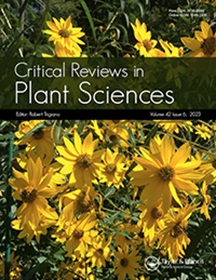水稻白叶枯病抗性基因的遗传、分子机制及定位
IF 6
2区 生物学
Q1 PLANT SCIENCES
引用次数: 18
摘要
水稻是南亚和东南亚人民的主要粮食作物,也是全球数百万农村家庭的生命线。细菌性白叶枯病(BB)是一种非常普遍、广泛和具有高度破坏性的水稻病害。近年来,通过引进对氮敏感的高产水稻品种,热带水稻的生产力水平提高了许多倍。氮肥用量大、湿度大的水稻连作加重了病害的发生。化学控制措施的成本很高,而且往往对环境产生不利影响。因此,发展寄主-植物抗性是控制病害的首选方法。米黄单胞菌病原菌分化的进化。oryzae (Xoo)分离株经常导致对该疾病的抵抗力崩溃。部署r基因组合的努力对于控制这种疾病更为重要。在寄主植物中,通过基因金字塔的方法,精确的基因整合可以获得持久和广谱的抗性。迄今为止,在水稻中已鉴定出45种具有这种疾病抗性的基因。基因对基因的抗性概念支配着宿主和Xoo菌株之间的种族特异性相互作用。植物已经发展出不同的内在机制来防御病原体的入侵。病原菌还进化产生变异的效应物,以对抗模式触发的免疫,并将寄主植物的反应转化为效应物触发的易感性。本文综述了水稻抗性基因的鉴定、抗性机制以及抗性基因的利用等方面的研究进展。本文章由计算机程序翻译,如有差异,请以英文原文为准。
Genetics, Molecular Mechanisms and Deployment of Bacterial Blight Resistance Genes in Rice
Abstract Rice is the principal food crop for people in South and South-East Asia and is life for millions of rural households worldwide. Bacterial blight (BB) is a very common, widespread, and highly destructive disease of rice. By the introduction of nitrogen-responsive high-yielding rice varieties, there was many-fold increase in the productivity level of tropical rice in recent years. Continuous cropping of rice with high nitrogen use and general wet conditions aggravated the disease incidence. The cost of chemical control measures is high and often shows adverse effects on the environment. Development of host-plant resistance is therefore a preferred approach to control the disease. Evolution of pathogen differentiation in the Xanthomonas oryzae pv. oryzae (Xoo) isolates often causes the breakdown of resistance against the disease. Efforts to deploy R-genes combinations are more important for managing the disease. Durable and broad-spectrum resistance may be achieved in host plants by precise gene incorporation through gene-pyramiding approach. To date, 45 genes conferring resistance to this disease have been identified in rice. The gene-for-gene concept of resistance governs the race-specific interaction between the host and the Xoo strains. Plants have developed different intrinsic mechanisms to defend the pathogen invasion. The pathogen also evolves to produce effectors with variation to counter the patterns-triggered immunity and convert the host plants response for effector-triggered susceptibility. This review discusses the progress in the identification of resistance genes, mechanisms of resistance, and deployment of resistance genes for durable and stable resistance in rice.
求助全文
通过发布文献求助,成功后即可免费获取论文全文。
去求助
来源期刊
CiteScore
12.90
自引率
1.40%
发文量
15
审稿时长
>12 weeks
期刊介绍:
Critical Reviews in Plant Sciences focuses on presenting in-depth and up-to-date reviews of timely and/or cutting-edge subjects in the broad discipline of plant science, ranging from molecular biology/biochemistry through the areas of cell biology, plant pathology and physiology, genetics, classical botany, and ecology, to practical agricultural applications. Articles in the journal provide an up-to-date literature base for researchers and students, pointing the way towards future research needs. The journal is also a significant source of credible, objective information to aid decision makers at all levels.

 求助内容:
求助内容: 应助结果提醒方式:
应助结果提醒方式:


